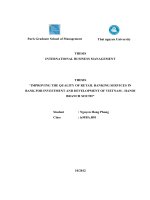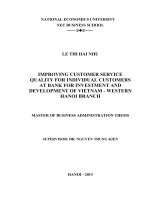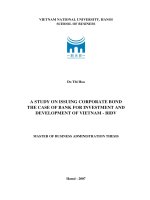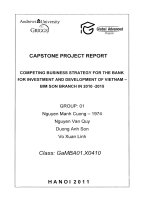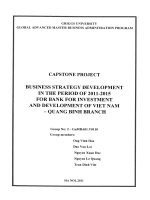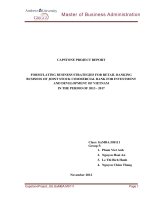Credit risk management at joint stock commercial bank for investment and development of vietnam, hong ha branch
Bạn đang xem bản rút gọn của tài liệu. Xem và tải ngay bản đầy đủ của tài liệu tại đây (1.34 MB, 98 trang )
ĐẠI HỌC QUỐC GIA HÀ NỘI
KHOA QUẢN TRỊ VÀ KINH DOANH
---------------------
HOÀNG LỆ THỦY
CREDIT RISK MANAGEMENT AT JOINT STOCK COMMERCIAL
BANK FOR INVESTMENT AND DEVELOPMENT OF VIETNAM,
HONG HA BRANCH
QUẢN TRỊ RỦI RO TÍN DỤNG TẠI NGÂN HÀNG TMCP ĐẦU TƯ
VÀ PHÁT TRIỂN VIỆT NAM CHI NHÁNH HỒNG HÀ
LUẬN VĂN THẠC SĨ QUẢN TRỊ KINH DOANH
HÀ NỘI - 2019
ĐẠI HỌC QUỐC GIA HÀ NỘI
KHOA QUẢN TRỊ VÀ KINH DOANH
---------------------
HOÀNG LỆ THỦY
CREDIT RISK MANAGEMENT AT JOINT STOCK COMMERCIAL
BANK FOR INVESTMENT AND DEVELOPMENT OF VIETNAM,
HONG HA BRANCH
QUẢN TRỊ RỦI RO TÍN DỤNG TẠI NGÂN HÀNG TMCP ĐẦU TƯ
VÀ PHÁT TRIỂN VIỆT NAM CHI NHÁNH HỒNG HÀ
Chuyên ngành: Quản trị kinh doanh
Mã số: 60 34 01 02
LUẬN VĂN THẠC SĨ QUẢN TRỊ KINH DOANH
NGƯỜI HƯỚNG DẪN KHOA HỌC: TS. TRẦN HUY PHƯƠNG
HÀ NỘI - 2019
DECLARATION
I pledge that the findings in the thesis are my own work results
obtained primarily during study and research and have not published yet in
any other research projects by others.
Research findings and other people’s materials (quotations, tables,
figures, formulas, graphs, and other materials) used in this thesis have been
agreed by the authors and cited.
I am fully responsible to the Board of Thesis Defense, School of
Business and Management and the law for the above commitments.
Author
Hoang Le Thuy
i
ACKNOWLEDGEMENTS
I would like to express my deepest gratitude to all of the following
people for helping me complete my thesis.
Firstly, I would like to express my special thanks to my company for
giving favorable conditions for my study and my master thesis completion at
Hanoi school of business and management (HSB).
Secondly, I am extremely grateful to all of the lecturers from the
Department of Business Administration - HSB for providing me with
research methods and professional knowledge during the course, especially
the active and creative research skills.
My appreciation also goes to the teachers in the thesis review committee
for giving me valuable ideas during my thesis completion process.
My profound gratitude is also conveyed to my instructor for his helpful
assistance and guidance. This thesis could have never been completed
without his enthusiastic counsel and support.
Despite the efforts during the research period, there are still many
limitations in the thesis. I would hope to receive valuable comments from the
teachers and co-workers to make this essay more complete.
Thank you very much./.
ii
TABLE OF CONTENTS
DECLARATION ............................................................................................... i
ACKNOWLEDGEMENTS .............................................................................. ii
TABLE OF CONTENTS ................................................................................. iii
LIST OF ABBREVIATIONS .......................................................................... vi
LIST OF TABLES .......................................................................................... vii
LIST OF FIGURE .......................................................................................... viii
INTRODUCTION ............................................................................................. 1
CHAPTER
1.
THEREOTICAL
BASES
OF
CREDIT
RISK
MANAGEMENT AT COMMERCIAL BANKS ............................................. 9
1.1. Concepts and classification of credit risk .................................................. 9
1.1.1. Concepts of risk ................................................................................... 9
1.1.2. Concepts of credit risk ......................................................................... 9
1.1.3. Characteristics of credit risk .............................................................. 11
1.1.4. Classification of credit risks............................................................... 11
1.1.5. Credit risk evaluation criteria............................................................. 14
1.2. Necessity of ensuring the credit risk management efficiency in
commercial banks............................................................................................ 17
1.3. Credit risk management procedures at commercial banks ...................... 18
1.4. Credit risk management experience of some commercial banks in the
world and in Vietnam ...................................................................................... 21
1.4.1. Experience of commercial banks in the world .................................. 21
1.4.2. Some risk management models being applied in Vietnam ................ 26
1.4.3. Risk management model application orientation .............................. 28
CHAPTER 2. CURRENT STATUS OF CREDIT RISK MANAGEMENT
AT BIDV-HONG HA BRANCH ................................................................... 30
iii
2.1. Introduction of BIDV-Hong Ha Branch .................................................. 30
2.1.1. Establishment and development history of BIDV- Hong Ha Branch 30
2.1.2. Organizational structure ..................................................................... 30
2.1.3. Business results of BIDV- Hong Ha branch ...................................... 34
2.2. Current status of Credit Risk Management at BIDV- Hong Ha Branch . 36
2.2.1. Current status of Credit Risk Management at BIDV- Hong Ha Branch . 36
2.2.2. Evaluation of the risk management process at Hong Ha branch ....... 44
2.2.3. Survey results of credit risk management at BIDV- Hong Ha Branch.... 58
2.3. Evaluation of credit risk management at BIDV- Hong Ha Branch ......... 66
2.3.1. Achievements ..................................................................................... 66
2.3.2. Weakness in credit risk management ................................................. 68
CHAPTER
3.
SOLUTIONS
TO
IMPROVE
CREDIT
RISK
MANAGEMENT AT JOINT STOCK COMMERCIAL BANK FOR
INVESTMENT AND DEVELOPMENT OF VIETNAM- HONG HA
BRANCH. ....................................................................................................... 74
3.1. Mission, vision, objectives of BIDV to 2020 .......................................... 74
3.2. Credit risk management orientation of BIDV-Hong Ha branch to 2020. 74
3.2. Some solution to improve credit risk management at BIDV –Hong Ha
Branch ............................................................................................................. 77
3.2.1. Strict compliance with the lending procedures .................................. 77
3.2.2. Improvement of the credit appraisal and analysis quality ................. 77
3.2.3. Development of an effective information network ............................ 78
3.2.4. Development of a policy to limit a large outstanding loan of one or
several large customers. ............................................................................... 79
3.2.5. Perfection of the internal credit ranking system and the risk reserve
policy ......................................................................................................... 80
3.2.6. Establishment of the information system for the analysis,
assessment, identification, monitoring and prevention of credit risks ........ 81
iv
3.2.7. Solutions to deal with non-performing loans, enhance credit quality
control, establish sufficient risk reserves and ensure the system safety. ..... 82
3.2.8. Solutions to apply Basel II at BIDV .................................................. 83
REFERENCES ................................................................................................ 87
v
LIST OF ABBREVIATIONS
No.
Abbreviations
Meaning
1
NHTM
Commercial Bank
2
QTRR
Risk Management
3
QTRRTD
Credit Risk Management
4
CBTD
Credit Officer
5
6
NH TMCP DT&PT Viet
Nam
NHNN
Joint Stock Commercial Bank for
Investment
and
Development
of Vietnam (BIDV)
State Bank of Vietnam
vi
LIST OF TABLES
Table 2.1. Business results in the 2015-2017 period ...................................... 34
Table 2.2. Capital mobilization scale of BIDV –Hong Ha Branch in the 2015 2017 period ...................................................................................................... 35
Table 2.3. Credit scale of BIDV –Hong Ha Branch in the 2015 -2017 period .... 37
Table 2.4. Credit quality of BIDV- Hong Ha Branch in the 2015 – 2017 period .... 38
Table 2.5: Non-performing loan ratio of some commercial banks ................. 43
Table 2.6. Characteristics of respondents ....................................................... 59
Table 2.7. Officers’ assessment of the causes of credit risks from BIDV-Main
Operation Center ............................................................................................. 62
Table 2.8. Officers’ assessment of the causes of credit risks from BIDV-Hong
Ha Branch ........................................................................................................ 64
vii
LIST OF FIGURE
Figure 1.1. Classification of risks by the causes ............................................. 12
Figure 1.2. Credit risk management process at commercial banks ................ 20
Figure 2.1. Organizational structure of BIDV- Hong Ha Branch ................... 32
Figure 2.2. Organizational structure of BIDV ................................................ 33
Figure 2.3. Internal credit ranking model for corporate customers ................ 52
Figure 2.4. Internal Credit Ranking Scoring Model ....................................... 54
viii
INTRODUCTION
1. Rationale
The income of commercial banks is mainly from credit activities,
which are considered their basic activities. The more developed the economy
is, the more developed and diversified commercial banks’ lending activities
are. In fact, income from credit activities accounts for 80-85% of total income
of banks and outstanding loans account for more than 60% of total assets.
Thus, it can be said that credit activities are still traditional business activities
of commercial banks in Vietnam nowadays. Meanwhile, retail development is
the target of many banks. Given the potentiality of young populations,
increasingly high per capita incomes and the increase in the middle class, the
orientation towards retail services has recently become a race. In particular,
traditional wholesale banks have shifted their focus towards retail and fierce
competition. According to the National Financial Supervisory Commission,
consumer loans increased by about 65% in 2017 meanwhile this indicator was
50.2% in 2016 and consumer credit accounted for 18% and 12.3% of total
outstanding loans respectively. It is forecasted that consumer credit will
continue increasing in the coming time. Therefore, according to the
development law of the economy, Joint Stock Commercial Bank for
Investment and Development of Vietnam (BIDV) - Hong Ha branch is also a
unit of continuous development, expansion of retail scale to increase
competitiveness, income and market share in the area.
Modern banking management science is increasingly developed and in
this system, risk management is a component. All banks now have a risk
management department but the risk still arises, which proves that their
objectivity and the performance of the risk management machinery and the
improvement of the risk management system of commercial banks still have
to be continued in the coming time.
1
The possibility of credit risk is enormous and the severity of the loss
depends on each particular case that does not follow any general rule. No talented
banker can accurately predict future problems with his or her credit and credit risk
is viewed as a fellow-traveler in the business. Strict and aggressive management
measures to minimize risks and losses to the Bank are essential.
Therefore, more than ever, credit risk management at commercial
banks in general and Joint Stock Commercial Bank for Investment and
Development of Vietnam (BIDV)- Hong Ha Branch in particular (hereinafter
referred to as BIDV Hong Ha) becomes increasingly important and necessary
to ensure safe and effective business. As a result, the author selected “Credit
Risk Management at Joint Stock Commercial Bank for Investment and
Development of Vietnam- Hong Ha Branch” as her research topic.
2. Research objectives
Overall objectives
The research objective of the thesis is to focus on finding out solutions to
improve credit risk management by designing a credit risk management model.
Specific objectives
Systematize the theoretical basis of credit risk management in business
activities at commercial banks.
Analyze the current status of credit risk management at BIDV in 2015,
2016, 2017. Evaluate the strengths/weaknesses of credit risk
management. Find out the causes of weaknesses.
Propose solutions to improve credit risk management at BIDV - Hong
Ha Branch.
3. Research Subject and Scope
Research subject: Credit Risk Management at Joint Stock Commercial
Bank for Investment and Development of Vietnam- Hong Ha Branch.
2
Research contents: The thesis focuses on theoretical and practical
issues of credit risk management at BIDV - Hong Ha Branch.
Research space: Business activities of the bank, focusing on credit risk
management at BIDV- Hong Ha Branch
Research time: Secondary data from 2015 to 2017 collected from the
annual reports of BIDV - Hong Ha Branch. Primary data is the result of
a survey conducted between June 2018 and October 2018.
4. Literature review
With the increasingly drastic development of the economy in general
and financial activities in particular, there have been many researches on
credit risk management. Credit risk management in commercial banks is seen
as a practical, urgent and ongoing issue that is closely linked to the diverse
development of the economy. There were many researches on credit risk and
credit risk management by researchers as well as specialists in the past time.
Some of these researches are:
Credit risk management at Vietnam Joint Stock Commercial Bank
for Industry and Trade by Nguyen Duc Tu (2012) – Doctoral
Dissertation in Economics, National Economics University. The thesis
proposed a new concept of credit risk, which differed from that of
many economists and managers in Vietnam, emphasizing the
possibility for unexpected differences between the real income and
expected income on maturity, sufficient principal and interest. Credit
risk would lead to unexpected financial losses, i.e., decrease in net
income and decrease in market value of capital. This concept was an
important theoretical basis for identifying the specific contents of credit
risk management. The dissertation developed the theoretical system of
credit risk management of banks with the following contents:
3
Designing the credit risk management model in the direction of
approaching modern risk management methods; applying credit risk
management evaluation model; improving the efficiency and
transparency of bank credit risk management; developing new policies
from post-inspection, consultancy to decision-making and manage
loans based on the credit analysis and review system.
Credit risk management at Vietnam Bank for Agriculture and Rural
Development (Agribank) by Nguyen Tuan Anh (2012) – Doctoral
dissertation in Economics, National Economics University. The thesis
made new contributions in academic and theoretical terms. Applying
the concepts of credit risk and credit risk management to Vietnamese
commercial banks in the international economic integration period, the
dissertation proposed a full range of qualitative and quantitative criteria
to evaluate the efficiency of credit risk management in Vietnamese
commercial banks in general, which previous studies in Vietnam have
not fully provided. These content and criteria were an important
scientific basis for developing and ensuring the success of a complete
credit risk management strategy at Vietnamese commercial banks in
general and Agribank in particular. Based on the set forth criteria, the
dissertation pointed out the weaknesses of credit risk management at
Agribank such as the backdated credit risk management model; the
lowest CAR compared to other state-owned commercial banks
(SOCBs); low owner’s equity structure; the ineffective customer rating
system; incomplete debt classification and imperfect risk reserve
establishment.
The
dissertation
also
proposed
risk
reserve
establishment of Agribank as well as emphasizes the need to quickly
change the credit risk management model; set up the Risk Management
Committee, reassign the tasks of each unit and build the reporting
4
system according to international standards. The dissertation also gave
some recommendations to the State, the State Bank of Vietnam and
some relevant ministries to focus on improving the legal environment,
amending the Land Law, creating a good legal corridor for the property
sales handling regulation.
Credit risk management at Joint Stock Commercial Bank for
Investment and Development of Vietnam- Hanoi Branch by Le Khac
Thai (2014); Master’s thesis of VNU- University of Engineering and
Technology. The thesis systematized credit risk and credit risk
management on the basis of application of Basel principle in designing
the credit risk management model for commercial banks in Vietnam.
The thesis analyzed and evaluated the current status of credit risk
management at BIDV - Hanoi Branch.
In sum, the above dissertations focused on the clarification and
systematization of credit risk and credit risk management according to Basel
principles and the Moody’s and Standard & Poor's methods in designing the
credit risk management model for commercial banks in Vietnam. However,
due to the relentless transformation of the economy and the objective and
subjective risk factors as well as the particular characteristics of the economy
in each country, the application of economic models and methods in the world
to Vietnam needs to be transformed and adapted to the economy. As a result,
the development of a credit risk management model for commercial banks in
Vietnam also needs to change. The criteria for assessing and classifying
individual and corporate customers must be take a closer look at more angles.
It is essential to update Basel II Principles and Circular No. 02/2013/TTNHNN dated January 21, 2013 by the State Bank of Vietnam on classification
of assets, deduction level, method of risk reserve establishment to deal with
risks in the operations of credit institutions and foreign bank branches,
5
thereby perfecting the credit risk management model for commercial banks in
Vietnam in general and BIDV - Hong Ha Branch in particular.
Although there are a lot of topics on credit risk management at banks,
at present, there is no research topic with the same space and time as that of
the author, in particular the research at BIDV-Hong Ha. Moreover, the author
is an officer who directly works in the credit field, so it is easy for her to
access accurate data and understand the credit field. As a result, the thesis still
ensures the novelty and practical applicability.
5. Research methods
To conduct this research, the author used the qualitative research
methods, mainly comparison, reconciliation and case study. Collected data
included primary data and secondary data. In particular, the secondary data
were collected through newspapers and monographs on risk management, the
consolidated reports of the branch, the comparison data from other
commercial banks, etc. to have the most comprehensive look on risk
management and retail credit of banks in general.
The primary data were collected through two methods, including indepth interviews with risk management experts and credit officers and the
sociological survey methods through questionnaires. The author focused on
the direct interview method through built-in scripts and sociological surveys
on a variety of respondents. Interview scripts and questionnaires are presented
in detail in the appendix of this thesis.
Research steps: To conduct this research, the author used the
following research process:
6
Source: The author (2018)
Sampling method
For the accurate and suitable survey results for the research topic, the
thesis presented 2 forms of Questionnaire:
Questionnaire form 1: is used to survey the Managers and credit
officers. This tool will have in-depth questions about credit risk
management and divided into three main contents: (1) identification of
the characteristics of the respondents; (2) Evaluation and identification
of causes from the Main Operation Center; (3) Evaluation and
identification of causes from BIDV -Hong Ha.
Questionnaire form 2: is used to survey customers. This form only
contains some questions about the relationship between banks and
customers in the lending and debt collection process.
7
Sample description
Due to the number of credit officer of Hong Ha branch was not large
(about 50 staff), so the author sent 50 samples to credit officers of BIDVHong Ha. After delivering 50 samples to credit officers, 39 valid ones and 11
invalid ones were collected.
The data collected from the questionnaires was processed and analyzed
by using a support tool- Excel software. The analytical method used is the
descriptive statistics with the aim of pointing out the respondents’ ideas on the
information of respondents, their opinions on the cause of difficulties in credit
risk management at BIDV-Hong Ha, which is an important objective basis
that the author used in analyzing and explaining the weaknesses in BIDVHong Ha’s credit risk management in the recent years.
6. Design of the thesis
Apart from the introduction and conclusion, the author intends to divide
the thesis into 3 chapters:
Chapter 1: Theoretical bases of Credit Risk Management at
Commercial Banks.
Chapter 2: Current status of Credit Risk Management at Joint Stock
Commercial Bank for Investment and Development of Vietnam- Hong
Ha Branch.
Chapter 3: Solutions to improve Credit Risk Management at Joint
Stock Commercial Bank for Investment and Development of VietnamHong Ha Branch.
8
CHAPTER 1. THEREOTICAL BASES OF CREDIT RISK
MANAGEMENT AT COMMERCIAL BANKS
1.1. Concepts and classification of credit risk
1.1.1. Concepts of risk
There have been no uniform definition of risk so far. Different schools
and different authors have given different definitions of risk. According to the
Vietnamese Dictionary published by Hanoi Dictionary Center in 1995, “Risk
is a bad thing which is not good and occurs unexpectedly”. According to the
Oxford Dictionary, “Risk is the possibility to be in danger or to be hurt, suffer
damages, etc.” In the “Risk management and insurance” book by C.Arthur
William, Jr. Micheal, L. Smith, wrote “Risks are potential fluctuations in
results. Risk can appear in almost every human activity. When there is a risk,
one cannot predict the result exactly. The presence of risk causes uncertainty.
The risk arises whenever an action leads to the unpredictable gains or loss.”
Frank Knight, an early 20th century American scholar, defined “Risk is
measurable uncertainty.”
“Risk is an uncertainty that may be related to an unexpected event,”
Alain Willet said. Thus, the definitions are different but they are consistent in
the content: “the risk is an unexpected thing that causes damages and can be
measured. Risk leads to unexpected losses and damages and risk is also the
uncertainty, so it does not depend on the subjective will of man. Therefore,
for the goal of survival and development, businessmen should be early
predicted and diagnosed the possible risks and solutions to prevent and accept
risks at reasonable levels to minimize the possible losses.
1.1.2. Concepts of credit risk
Concept of credit granting: Credit granting is an agreement for
organizations or individuals to use a sum of money or a commitment to allow
9
the use of a sum of money on the principle of repayment by lending, financial
leasing, factoring, bank guarantee and other credit operations (According to
the Law on Credit Institutions (2010)).
Pursuant to Circular No. 02/2013/TT-NHNN dated January 21, 2013 on
“Regulations on classification of assets, deduction level, method of risk
reserve establishment to deal with risks in the operations of credit institutions
and foreign bank branches”, credit risk in banking activity is the potential loss
to a debt of a credit institution or a foreign bank branch due to a customer’s
failure or inability to perform part or all of its obligations under the
commitment. “Simply, credit risk is defined as the possibility of the borrower
or the bank’s partner’ failure to perform obligations under the agreed terms”
(Basel II). “Credit risk occurs when the creditors, obligors or partners fail to
perform or are unable to perform part or all of their committed obligations”
(Draft Circular on Regulations on Risk Management System in Banking
Operations (2014)).
Accordingly, credit risk is understood as the risk arisen due to the
borrower’s failure to comply with the provisions of the credit contract with
the specific expression such as late debt repayment, incomplete debt
repayment or no debt repayment of principal and interest on maturity,
resulting in financial losses and difficulties in business activities of
commercial banks.
Factors constituting credit risk:
Different customers and different professions have different risks;
Different products (consumer loans or production and business loans,
secured loans or unsecured loans, etc.) have different risks;
Credit officers’ qualification and virtues, credit management policies
and resources of the bank (including IT system) can make a positive
contribution to reducing credit risk.
10
1.1.3. Characteristics of credit risk
According to Joel Bessis (2011), Risk Management in Banks
(Vietnamese translation version), Labour and Social Publishing House, credit
risk has the following characteristics:
Credit risk is passive: Credit losses for a bank occur only after the bank
disburses loans, or in other words, in the process of using loans by the customer.
The customer directly uses loans, so she/he have sufficient information of the
quality and efficiency of using the loans. Therefore, the bank often remains
passive because it knows the information later or has inaccurate and insufficient
information of the customer’s difficulties and failures in business in general and in
the use of loans in particular, making it often delayed in response.
Credit risk is diversified and complicated: The diversified and
complicated nature of borrowers, creditors, credit types, causes and consequences,
etc. make credit risk become more diverse and complicated. As a result, banks
must focus more on credit risk management, from the establishment of credit
policies, the use of risk management tools to management processes in the
identification, measurement, processing and control of credit risk.
Credit risk is indispensable: Any business activity is associated with risk,
in which the credit activity of the bank is no exception. Risk acceptance is inevitable
in banking credit operations based on a “risk-profit” relationship in order to find out
opportunities to achieve a profit that is compatible with the acceptable risk. The
Bank will ensure safe and effective operation when the risk is acceptable and
controllable and within its financial resources and business capacity.
1.1.4. Classification of credit risks
There are many different ways of classifying and approaching credit
risk. According to Assoc. Dr. Dinh Xuan Hang, MA., Nguyen Van Loc
(2012), “Credit management at commercial banks” textbook, Finance
Publishing House; the exact classification of credit risk should be based on
the following criteria:
11
1.1.4.1. Causes of risks
Transaction risk: means the risk involved in each individual loan or
individual customer. This type of risk originates from the weaknesses in the
operation process such as credit appraisal and approval, disbursement, postlending control or loan security and commitments in the credit agreement.
Credit portfolio risk: is the risk that is caused by the limitations of the
bank’s credit portfolio management, including internal risk and
concentration risk. Internal risk derives from the internal factors of each
customer or industry, economic sector and depends on the customer’
operation or loan use characteristics. Concentration risk refers to the case
where the bank concentrates excessive credit on one or several customers
in one/some sectors/fields or in one/some certain geographic area.
Credit risks
Transaction risk
Credit portfolio risk
( Related to each credit item)
(Related to credit portfolio)
Selection
Risk
(occurrin
g before
the credit
decision)
Operation
risk
(occurrin
g in credit
managem
ent)
Guarantee
risk
(occurring
in the
terms of
the
Contract
and
Collateral
)
Internal risk
(relative to
the
characteristi
cs of each
type of
credit
product)
Concentr
ation risk
(due to
undiversif
ied credit
portfolio)
Figure 1.1. Classification of risks by the causes
Source: “Credit management at commercial banks” textbook
12
1.1.4.2. Loss levels
Risk of stagnant capital (due to late debt repayment): The risk occurs
when the bank has not collected debts on the due date under the agreement
yet, leading to the frozen capital (less liquid) and affecting the bank’s
capital use plan, causing difficulties in liquidity management.
Risk of capital loss (due to borrower’s insolvency): The risk occurs
when the customer is unable to repay principal and/or interest, forcing
the bank to dispose of the collateral for debt collection. The risk of
capital loss increases the cost of bad debts and supervision cost and
reduces the profits due to the increase in credit risk reserve.
1.1.4.3. Origin of risks
Risks from the Bank: are risks caused by the Bank’s policies,
research, forecasting, monitoring, management of credit risk, credit
officers, ineffective supervision and control.
Risk from the borrower: is the main risk in the types of credit risk.
For example: Weak financial capacity risk, business operation risk, etc.
Risks from other causes: are the risks related to the management of
the State Bank; policies; environment; unusual fluctuations in the
economy, etc. Or objective causes such as natural disasters, enemy
sabotage, disappearance or death of borrowers and other force majeure
events that result in credit losses meanwhile the customer and the bank
has strictly followed the credit policies and procedures as well as the
contents stipulated in the credit contract.
1.1.4.4. Risk occurence time
Risks before lending: occurs during the record preparation and credit
analysis process that leads to loan disbursement to ineligible customer
who is unable to repay the loan in the future.
13
Risk during lending: occurs during the disbursement process. The causes
of this risk are: disbursement errors, late disbursement, failure to update
customer information regularly or failure to forecast potential risks.
Risks after lending: occurs when the bank fails to grasp the situation
and the purpose of using the loan, changes in the financial position as
well as the debt repayment goodwill of the customer.
1.1.4.5. Range of credit risks
Particular credit risk: occurs only for a single loan of a customer, a
portfolio or a specific sector/field. Some causes of a particular risk are
characteristics of the industry/business area of customers, abnormal
changes in the financial position, management capacity as well as
goodwill, ethics of customers.
Systematic credit risk: occurs not just for a credit, a customer, a bank
but for the whole system with the spreading effect throughout the
banking sector. Some causes of systematic risk are changes in
government policies affecting the financial position and debt repayment
capacity of customers, negative macroeconomic impact on customers
and social and political unrest and unforeseen causes from the natural
and external environment.
1.1.5. Credit risk evaluation criteria
Credit risk is associated with the most important and largest activity of
commercial banks - credit activity. Although risk is often associated with the
benefits (The higher the risk is, the greater the expected return for the bank
is), when performing a specific financing activity for the customer, the bank
tries to analyze the factors of the borrower to ensure the highest safety of the
loan and the bank only decides to grant credit when it sees that credit risk is
impossible. However, it is difficult to predict exactly what will happen in the
14
future, the repayment capacity of customers can be changed for many reasons.
Moreover, many bank officers are not able to analyze credit appropriately. As
a result, from an overall bank management perspective, credit risk is objective
and unavoidable. Banks need to evaluate the customers’ loan use
opportunities based on the risk-benefit relationship in order to find
opportunities to obtain benefits that are worth the risk that the bank can
accept. In business, risk can be taken precautions and limited but cannot be
eliminated. Therefore, the anticipated risk is always predetermined in the
bank’s general operational strategy.
Credit risk can occur in 4 cases of interest and principal debt, including
late interest repayment or insufficient interest repayment or late principal
repayment or insufficient principal repayment that all lead to overdue debts.
When the interest is not paid on time, the risk is low and only included in the
unpaid interest. If the bank cannot collect interest fully, there will be frozen
interest, except for cases where the bank exempts customers from that
interest. If the principal is not collected on the due date, the bank will have
overdue debt. However, this overdue debt cannot be considered as a complete
loss of the bank because it is possible for some reason that customer delays
principal repayment and will pay it after the committed due date under the
contract. If this principal cannot be recovered (due to customer’s insolvency),
then the bank is considered to be exposed to high credit risk.
Credit risk exists in many forms, which are constantly changing but the
final level is irrecoverable debt. When studying credit risk, people often focus on
the potential risks such as unpaid interest, especially overdue debt, frozen interest
and irrecoverable overdue debt that are considered as real risk situations, so they
are often considered to address the consequences and draw lessons.
The Bank’s bad debt ratio of below 3% is considered to be within the
permitted safety limit under the Government’s Resolution No. 01/NQ-CP
15
